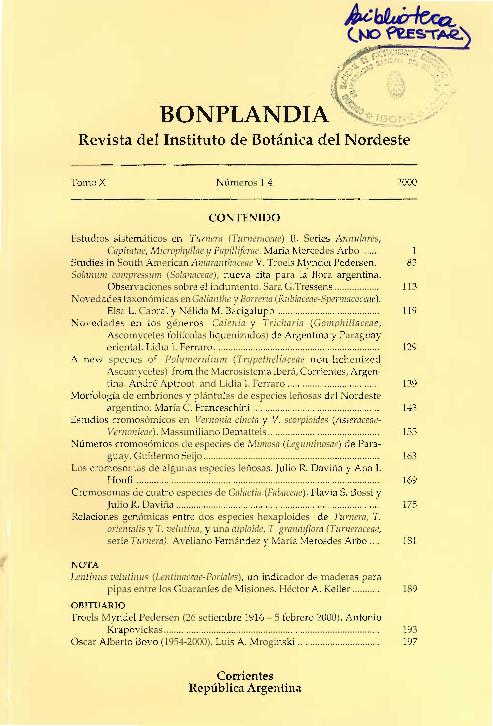Mostrar el registro sencillo del ítem
dc.contributor.author
Arbo, Maria Mercedes

dc.date.available
2017-12-07T19:36:13Z
dc.date.issued
2000-12
dc.identifier.citation
Arbo, Maria Mercedes; Estudios sistemáticos en Turnera (Turneraceae). II. Series Annulares, Capitatae, Microphyllae y Papilliferae; Instituto de Botánica del Nordeste; Bonplandia; 10; 1-4; 12-2000; 1-82
dc.identifier.issn
0524-0476
dc.identifier.uri
http://hdl.handle.net/11336/30009
dc.description.abstract
Turnera L. includes around 100 American species and two African ones, arranged in nine series. In this paper, the following four series embracing 21 species are revised: Annulares, Capitatae, Microphyllae and Papilliferae. Six new taxa are described: T.hatschbachii, T.hatschbachii var. miniata, T.maracasana, and T.princeps of the series Capitatae, T.asymmetríca of the series Microphyllae, and T.caatingana of the series Papilliferae. The species of these four series share the common features of simple and glandular hairs, generally well-developed floral peduncle, absent pedicel, linear or elliptic prophylls, generally warty or granulate fruit, and a floral tube, appendicular in nature, in that it is the product of the fusion of the lower part of the calyx and corolla, with the staminal filaments adnate only at the base. In the series Annulares, Microphyllae and Papilliferae the leaves and young stems are fragrant, the scent being produced by the glandular hairs, and the floral peduncle is shortly adnate to the petiole. Three series, Annulares, Capitatae and Microphyllae, have leaves with generally well developed stipules and a disjunct geographical distribution. The series Annulares and Capitatae have nectaries and villous or hirsute styles, while Microphyllae and Papilliferae lack nectaries and their styles are glabrous or somewhat pilose. In some species of Microphyllae the staminal filaments are joined at the base, forming an annular structure 0,05-0,50 mm high. The seeds are peculiar in Annulares, being very short, with a central, prominent and slightly concave chalaza. In the series Capitatae, the flowers are gathered in short, capitate inflorescences, the length of the peduncles being variable or sometimes wanting, and the seeds are obovoid, reticulate or striate. The leaves of Microphyllae are small, with the stipules adnate to the foliar base; setiform glandular hairs, similar to those of Piriqueta, are exclusive to Turnera collotricha. The only series in the genus with stipitate glandular hairs is Papilliferae. Keys for the identification of series and species as well as illustrations and distribution maps are provided.
dc.format
application/pdf
dc.language.iso
spa
dc.publisher
Instituto de Botánica del Nordeste
dc.rights
info:eu-repo/semantics/openAccess
dc.rights.uri
https://creativecommons.org/licenses/by-nc-sa/2.5/ar/
dc.subject.classification
Otras Ciencias Biológicas

dc.subject.classification
Ciencias Biológicas

dc.subject.classification
CIENCIAS NATURALES Y EXACTAS

dc.title
Estudios sistemáticos en Turnera (Turneraceae). II. Series Annulares, Capitatae, Microphyllae y Papilliferae
dc.type
info:eu-repo/semantics/article
dc.type
info:ar-repo/semantics/artículo
dc.type
info:eu-repo/semantics/publishedVersion
dc.date.updated
2017-12-04T17:28:40Z
dc.identifier.eissn
1853-8460
dc.journal.volume
10
dc.journal.number
1-4
dc.journal.pagination
1-82
dc.journal.pais
Argentina

dc.description.fil
Fil: Arbo, Maria Mercedes. Consejo Nacional de Investigaciones Científicas y Técnicas. Centro Científico Tecnológico Conicet - Nordeste. Instituto de Botánica del Nordeste. Universidad Nacional del Nordeste. Facultad de Ciencias Agrarias. Instituto de Botánica del Nordeste; Argentina
dc.journal.title
Bonplandia
dc.relation.alternativeid
info:eu-repo/semantics/altIdentifier/url/http://revistas.unne.edu.ar/index.php/bon/article/view/1452
Archivos asociados
